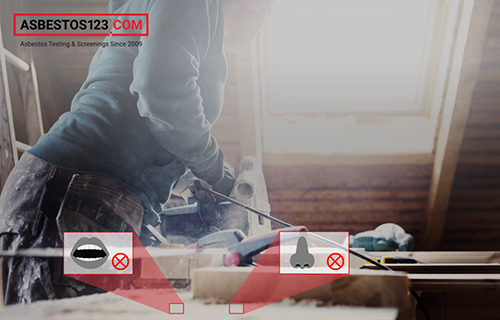What Does Asbestos Smell Like?

Up until the 1980s, asbestos was used in a variety of construction materials. Insulation, electrical wires, pipes, concrete, joint compound, floor shingles, roofing and siding, windows putty, paint, linoleum, and other building products all contained asbestos.
Asbestos in the home can be found in one of two forms. The most common is found in firmly bound material, such as vinyl floor tiles, cement sheets, bitumen-based waterproofing, imitation brick cladding, and textured decorated coatings.
The second can be found in the form of loose asbestos fibers also referred to as "friable". Un-bonded asbestos was used in certain types of insulation products for hot water pipes, hot water systems and stoves manufactured before the 1980s, and ceiling insulation. If disturbed, friable asbestos products are dangerous because the fibers can get into the air very easily, and can be inhaled by people living in the area. What you wonder now, is if it's possible to tell by smelling if building materials contain asbestos.
Asbestos Is Odorless, and Tasteless, and Pose a Threat When Its Fibers Are Released Into the Air and Breathed In
Asbestos has been around since the days of the Ancient Greeks and Romans and was prized for its strength, heat and corrosion resistance, and insulating properties.
According to the U.S. Agency for Toxic Substances and Disease Registry, asbestos fibers:
- do not evaporate into the air
- do not dissolve in water
- do not break down to other compounds
- will remain virtually unchanged over long periods
There are no immediate signs of asbestos exposure, thus, if you come into direct contact with asbestos fibers by inhaling them when they are airborne, they will not make you cough, sneeze or itch. The symptoms of asbestos exposure often don't become apparent until many years after continued exposure.
Asbestos fibers can remain airborne as long as 48 to 72 hours and enter your lungs when you inhale. The odds of developing a life-threatening condition from a short or one-time exposure are low. Asbestos-related diseases are usually caused by several years of regular workplace exposure.
If You Can't Smell or Taste Asbestos, How Do You Know if It Is in a Product?
Our sense of smell serves as a warning system to avert potentially harmful chemicals and substances. It is important to bear in mind that asbestos-containing materials smell the same as non-asbestos containing materials.
Because asbestos does not have an associated smell, this begs the question: how can you tell something is asbestos?
Although asbestos have no distinctive smell, manufacturers made their asbestos-containing materials with a distinct look and feel. For instance, asbestos insulation - a common building product - has many different appearances:
- Loose-fill insulation - it can be identified by its loose, lumpy form and fluffy consistency
- Vermiculite insulation - looks like pebbles and typically is gray-brown or silver-gold in color
- Zonolite insulation - it has a silver-gold or gray-brown color, accordion-style texture particles, and will lay flat against a joist cavity.
In some cases, asbestos-containing products can be easily identified by a close-up visual inspection. Some products made with asbestos have unique characteristics and there were no identical or similar non-asbestos look-alike products. For example, asbestos-containing cement roof tiles are usually square-shaped and their color is a combination of grey and black.
When Is Asbestos in Your Home Dangerous?
If you've been told or suspect there is asbestos in your home - don't panic. The best thing to do with asbestos-containing material in good condition is to leave it alone. Any treatment that is recommended may vary depending on the type of asbestos material and whether it's bonded or friable.
Asbestos in the home is a risk when it is disturbed in a way that produces fibers. This could include demolition work, drilling, grinding, buffing, cutting, or striking, and so on.
